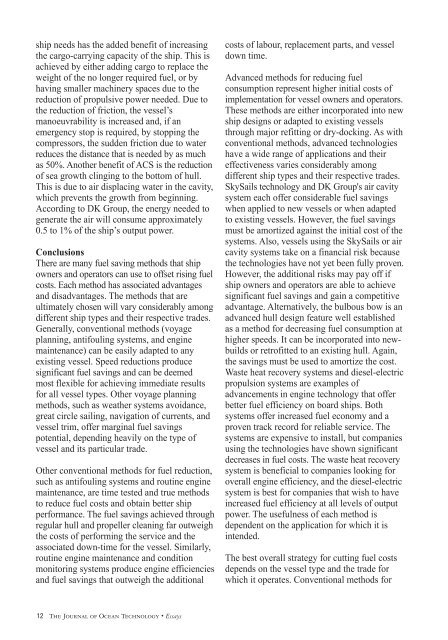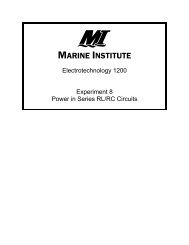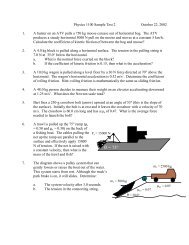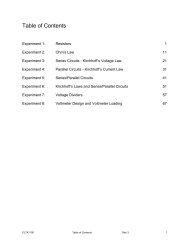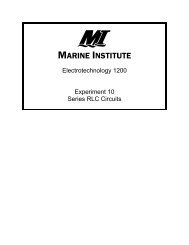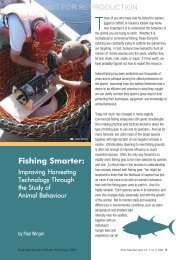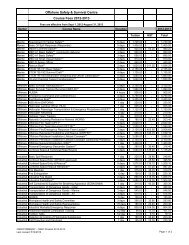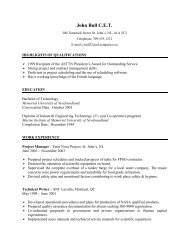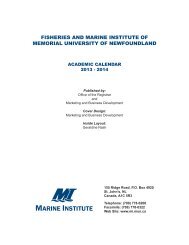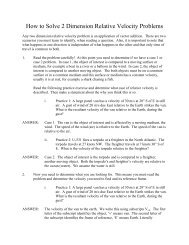Hybrid Marine Propulsion on the Tugboat Carolyn Dorothy
Hybrid Marine Propulsion on the Tugboat Carolyn Dorothy
Hybrid Marine Propulsion on the Tugboat Carolyn Dorothy
You also want an ePaper? Increase the reach of your titles
YUMPU automatically turns print PDFs into web optimized ePapers that Google loves.
ship needs has <strong>the</strong> added benefit of increasing<br />
<strong>the</strong> cargo-carrying capacity of <strong>the</strong> ship. This is<br />
achieved by ei<strong>the</strong>r adding cargo to replace <strong>the</strong><br />
weight of <strong>the</strong> no l<strong>on</strong>ger required fuel, or by<br />
having smaller machinery spaces due to <strong>the</strong><br />
reducti<strong>on</strong> of propulsive power needed. Due to<br />
<strong>the</strong> reducti<strong>on</strong> of fricti<strong>on</strong>, <strong>the</strong> vessel’s<br />
manoeuvrability is increased and, if an<br />
emergency stop is required, by stopping <strong>the</strong><br />
compressors, <strong>the</strong> sudden fricti<strong>on</strong> due to water<br />
reduces <strong>the</strong> distance that is needed by as much<br />
as 50%. Ano<strong>the</strong>r benefit of ACS is <strong>the</strong> reducti<strong>on</strong><br />
of sea growth clinging to <strong>the</strong> bottom of hull.<br />
This is due to air displacing water in <strong>the</strong> cavity,<br />
which prevents <strong>the</strong> growth from beginning.<br />
According to DK Group, <strong>the</strong> energy needed to<br />
generate <strong>the</strong> air will c<strong>on</strong>sume approximately<br />
0.5 to 1% of <strong>the</strong> ship’s output power.<br />
C<strong>on</strong>clusi<strong>on</strong>s<br />
There are many fuel saving methods that ship<br />
owners and operators can use to offset rising fuel<br />
costs. Each method has associated advantages<br />
and disadvantages. The methods that are<br />
ultimately chosen will vary c<strong>on</strong>siderably am<strong>on</strong>g<br />
different ship types and <strong>the</strong>ir respective trades.<br />
Generally, c<strong>on</strong>venti<strong>on</strong>al methods (voyage<br />
planning, antifouling systems, and engine<br />
maintenance) can be easily adapted to any<br />
existing vessel. Speed reducti<strong>on</strong>s produce<br />
significant fuel savings and can be deemed<br />
most flexible for achieving immediate results<br />
for all vessel types. O<strong>the</strong>r voyage planning<br />
methods, such as wea<strong>the</strong>r systems avoidance,<br />
great circle sailing, navigati<strong>on</strong> of currents, and<br />
vessel trim, offer marginal fuel savings<br />
potential, depending heavily <strong>on</strong> <strong>the</strong> type of<br />
vessel and its particular trade.<br />
O<strong>the</strong>r c<strong>on</strong>venti<strong>on</strong>al methods for fuel reducti<strong>on</strong>,<br />
such as antifouling systems and routine engine<br />
maintenance, are time tested and true methods<br />
to reduce fuel costs and obtain better ship<br />
performance. The fuel savings achieved through<br />
regular hull and propeller cleaning far outweigh<br />
<strong>the</strong> costs of performing <strong>the</strong> service and <strong>the</strong><br />
associated down-time for <strong>the</strong> vessel. Similarly,<br />
routine engine maintenance and c<strong>on</strong>diti<strong>on</strong><br />
m<strong>on</strong>itoring systems produce engine efficiencies<br />
and fuel savings that outweigh <strong>the</strong> additi<strong>on</strong>al<br />
costs of labour, replacement parts, and vessel<br />
down time.<br />
Advanced methods for reducing fuel<br />
c<strong>on</strong>sumpti<strong>on</strong> represent higher initial costs of<br />
implementati<strong>on</strong> for vessel owners and operators.<br />
These methods are ei<strong>the</strong>r incorporated into new<br />
ship designs or adapted to existing vessels<br />
through major refitting or dry-docking. As with<br />
c<strong>on</strong>venti<strong>on</strong>al methods, advanced technologies<br />
have a wide range of applicati<strong>on</strong>s and <strong>the</strong>ir<br />
effectiveness varies c<strong>on</strong>siderably am<strong>on</strong>g<br />
different ship types and <strong>the</strong>ir respective trades.<br />
SkySails technology and DK Group's air cavity<br />
system each offer c<strong>on</strong>siderable fuel savings<br />
when applied to new vessels or when adapted<br />
to existing vessels. However, <strong>the</strong> fuel savings<br />
must be amortized against <strong>the</strong> initial cost of <strong>the</strong><br />
systems. Also, vessels using <strong>the</strong> SkySails or air<br />
cavity systems take <strong>on</strong> a financial risk because<br />
<strong>the</strong> technologies have not yet been fully proven.<br />
However, <strong>the</strong> additi<strong>on</strong>al risks may pay off if<br />
ship owners and operators are able to achieve<br />
significant fuel savings and gain a competitive<br />
advantage. Alternatively, <strong>the</strong> bulbous bow is an<br />
advanced hull design feature well established<br />
as a method for decreasing fuel c<strong>on</strong>sumpti<strong>on</strong> at<br />
higher speeds. It can be incorporated into newbuilds<br />
or retrofitted to an existing hull. Again,<br />
<strong>the</strong> savings must be used to amortize <strong>the</strong> cost.<br />
Waste heat recovery systems and diesel-electric<br />
propulsi<strong>on</strong> systems are examples of<br />
advancements in engine technology that offer<br />
better fuel efficiency <strong>on</strong> board ships. Both<br />
systems offer increased fuel ec<strong>on</strong>omy and a<br />
proven track record for reliable service. The<br />
systems are expensive to install, but companies<br />
using <strong>the</strong> technologies have shown significant<br />
decreases in fuel costs. The waste heat recovery<br />
system is beneficial to companies looking for<br />
overall engine efficiency, and <strong>the</strong> diesel-electric<br />
system is best for companies that wish to have<br />
increased fuel efficiency at all levels of output<br />
power. The usefulness of each method is<br />
dependent <strong>on</strong> <strong>the</strong> applicati<strong>on</strong> for which it is<br />
intended.<br />
The best overall strategy for cutting fuel costs<br />
depends <strong>on</strong> <strong>the</strong> vessel type and <strong>the</strong> trade for<br />
which it operates. C<strong>on</strong>venti<strong>on</strong>al methods for<br />
12 The Journal of Ocean Technology • Essays


